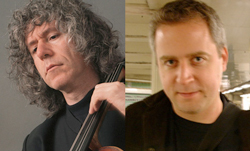by Daniel Hathaway
The 
In Cleveland, Isserlis built his program around both of Brahms’s sonatas, separated by Liszt’s own arrangements of early songs and prefaced by Bartók’s First Rhapsody and Busoni’s Finnish folk song variations. In Oberlin, he drew back the curtains on what could have been a typical chamber music concert in Paris during the Belle époque — that brief cultural golden age between the 1870s and the first World War — including two out-of-period works that fit right into the spirit of the occasion.
Venezuelan-born Reynaldo Hahn’s 1905 Variations chantantes sur un air ancien invoked the spirit of that age perfectly, as well as introducing the concert’s Proustian subplot of “time remembered.” Looking both backward and forward (the “old air” is by Cavalli and the harmonies are conventional but the rhythms and piano figurations are modernist), the brief Variations are charming and ingratiating. Isserlis mentioned later that this was probably the first American performance of the work, which Denk had heard about, but for which no score could be found. After “a world-wide search” Isserlis finally discovered a copy near his home, in the library of the Royal College of Music; he was the first to borrow it in seventy years!
Gabriel Fauré’s second sonata in g minor dates from 1921, but seems to come from somewhere in the composer’s earlier memory. Its opening Allegro is perhaps unusually chromatic, but its Andante is pure Fauré, a lovely melody simply supported by piano chords. The restless finale, marked Allegro vivo, tosses bits and pieces of themes back and forth between cello and piano, which Isserlis and Denk pitched and caught with expressive precision.
Another out-of-period but in-the-spirit work ended the first half. Thomas Adès’s Lieux retrouvés, written for Steven Isserlis, conjured up impressionistic memories of waters, mountains, fields and cities in the composer’s typically fresh and imaginative sounds. Laborious, plodding figures suggested mountain climbers. Impossibly high, lyrical themes which took Isserlis to the extremes of the fingerboard depicted the peace of animals at rest. Whistles and abrupt pauses marked the demented “Can-Can Macabre” of the final movement. Though Lieux must have frequently pushed the performers to the edge, the piece was nothing but fun for the audience.
The Romanza from Saint-Saëns’s 1905 second sonata, an affecting, episodic work interrupted by expressive cello cadenzas, opened the second half and led to the main event of the evening, Franck’s much-earlier Sonata in A. Dating from 1886, the piece was originally intended for the violin but its second printing opened the door to performances by cellists as well.
In the Franck, Isserlis and Denk were amazing in their ability to maintain a steady undercurrent of intensity even while allowing the surface of the music to completely relax during more melodic moments. They made the opening Allegretto remarkable for its extremes of dynamics and mood, and the usually craggy Allegro special for its lyricism. The intensity continued to ebb and flow through the improvisatory Recitative-Fantasia and the canonic line-trading in the final Allegretto, making an old war-horse sound as newly-discovered as the Hahn Variations.
Cheering and foot-stomping won the large audience an encore. A Saint-Saëns Romance sent a lot of happy people off into the snowy night.
Photos by Roger Mastroianni courtesy of the Oberlin Conservatory.
Published on ClevelandClassical.com February 7, 2013
Click here for a printable version of this article.



